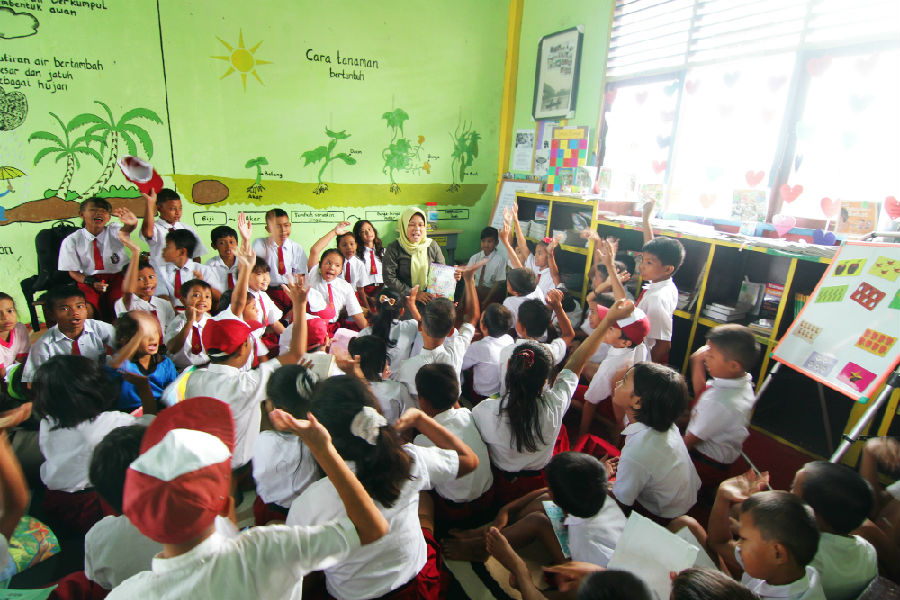(单词翻译:单击)
听力文本
Education in Indonesia Lags Behind Neighbor Countries
Indonesian students are among the lowest performers in Southeast Asia, says a recent report released by the Organization for Economic Cooperation and Development, OECD.
The OECD Program for International Student Assessment, PISA, is a test given every three years to 15-year-olds across 79 countries. It examines student ability in math, reading and science. The results from the 2018 PISA place Indonesia in the bottom 10 of the countries.
The findings point to education quality issues in Southeast Asia's most populous country.
"It's a wake-up call for all of us in the education sector," or field, said Totok Amin Soefijanto, a policy expert at Paramadina University in Jakarta.
Indonesia has a large youth population in the country of 260 million. These young people represent considerable possibilities for economic growth. However, education problems can interfere with that aim.
Poorly qualified teachers are a major problem. Sixty-five percent of students PISA questioned said their teachers rarely provided direct feedback to them. The Indonesian government uses teacher ability tests. In 2015, three million teachers in the country took the test. The average score was 53 percent, reported University of Melbourne professor Andrew Rosser, who examined the results.
The tests have not been repeated since then. Paramadina University's Soefijanto thinks they should be. "Because if we don't measure this," he said, "we don't know where their skills are decreasing."
One in five teachers often misses school, the World Bank reported in 2017.
Indonesian teachers also work for low wages and are often appointed as favors to others, Rosser says.

Hundreds of native languages are spoken in the island nation, adding to the complexity of its education system.
Under military ruler Suharto from 1965 to 1998, the Indonesian school system was highly centralized. But as the government moved towards democratic reform, control of educational policy began moving to local governments. Because Indonesia covers an area of 15,000 islands, this spread makes it difficult to establish national education guidelines or teacher qualifications.
The OECD report notes that Indonesia has made progress in getting children into school. From 2001 to 2018, those taking the PISA increased from 46 percent to 85 percent of 15-year-old students.
The report says increasing student populations can create weaknesses in school systems. It points out that Indonesia's PISA results have remained about the same since 2001, suggesting the country "has been able to raise the quality of its education system."
Indonesia's education minister, Nadiem Makarim, told the Indonesian newspaper Kompas that the PISA results "should not be packaged as good news." He announced this week that the country's national examination will be reworked to test students on math, reading and writing skills.
Math was a difficult PISA subject for Indonesian students. Just one percent of those tested performed at the highest levels. This compares to 44 percent in mainland China and 37 percent in Singapore.
Some resources for math and science study have been reorganized to support other subjects, such as religion. Almost two-thirds of the country's secondary schools are private and offer Islamic education. Students at these schools generally score lower on tests than students at nonreligious schools, a 2017 study reported.
Indonesia spent about 3.6 percent of its gross domestic product on education in 2015, lower than neighbors like Malaysia and Vietnam. The amount, however, observes a constitutional requirement to spend 20 percent of the national budget on education.
In the meantime, there is one area in which Indonesian students score high: 91 percent of them report "sometimes or always feeling happy," a full six points higher than the world average.
I'm Anne Ball. And I'm Bryan Lynn.
重点解析
重点讲解:
1. interfere with 妨碍;干扰;
It will seriously interfere with the progress of the work.
我将与你结伴到车站。
2. add to 增添;增进;
This latest incident will add to the pressure on the government.
最近的这次事件将会给政府增加压力。
3. point out 指明;说明;
Critics point out that the prince, on his income, should be paying tax.
批评家指出王子的收入应该纳税。
4. such as 比如;像这种的;
There are also unpleasant brain effects such as anxiety and neurotic behaviour.
也会对大脑产生不良影响,如焦虑和神经质的行为。
参考译文
印尼教育落后于邻国
经济合作与发展组织(OECD)最近发布的一份报告称,印尼学生是东南亚地区表现最差的学生之一。
经合组织的国际学生评估项目(PISA),是一项每三年对79个国家的15岁学生进行的测试。该测试考察学生在数学、阅读和科学方面的能力。2018年PISA测试的结果显示,印尼排在倒数10位的位置之中。
调查结果指出,东南亚人口最多的国家存在教育质量问题。
雅加达帕拉马迪纳大学(Paramadina University)政策专家托托科·阿明·索菲扬托表示:“这对我们所有教育领域的人来说,这都是一个警钟。”。
印度尼西亚有2.6亿青年人口,这些年轻人代表着经济增长的巨大可能性。然而,教育问题会干扰这一目标。
教师素质低是一个主要问题,65%的受访学生表示,他们的老师很少直接向他们提供反馈。印尼政府使用教师能力测试。2015年,全国有300万教师参加了考试。墨尔本大学(University of Melbourne)教授安德鲁·罗瑟对研究结果进行了检验,结果显示,平均得分为53%。
从那时起,就不再重复实施这些测试了。帕拉马迪纳大学的苏菲·贾托认为,他们应该这样做。“因为如果我们不这样衡量,”他说,“就不会知道他们的技能在哪里下降。”
世界银行(World Bank)2017年报告称,五分之一的教师经常缺课。
罗瑟说,印尼教师的工资也很低,通常并经常被别人所青睐。
岛上有数百种土著语言,这增加了教育系统的复杂性。
1965年至1998年,在军事统治者苏哈托的统治下,印尼的学校系统高度集中。但随着政府走向民主改革,教育政策的控制权开始转向地方政府。由于印度尼西亚有1.5万个岛屿,这种分布使制定国家教育准则或教师资格变得困难。
经合组织的报告指出,印度尼西亚在让儿童入学方面取得了进展。从2001年到2018年,参加PISA测试的15岁学生从46%增加到85%。
报告说,学生人数的增加会造成学校系统出现薄弱环节。报告指出,自2001年以来,印尼的PISA测试成绩基本保持不变,这表明印尼“已经能够提高其教育系统的质量。”
印尼教育部长纳迪姆·马卡里姆对印尼《罗盘报》(Kompas)表示,PISA的测试成绩“不应该被装扮成好消息”。他本周宣布,印尼国家考试将重新调整,测试学生的数学、阅读和写作能力。
对印尼学生来说,数学是一门难学的PISA测试课程。只有百分之一的受试者表现出最高水平。相比之下,中国大陆和新加坡分别为44%和37%。
一些用于数学和科学研究的资源已经重组,以支持宗教等其他学科。该国近三分之二的中学是私立学校,提供伊斯兰教育。2017年的一项研究报告称,这些学校的学生考试成绩普遍低于非宗教学校的学生。
2015年,印尼的教育支出约占国内生产总值的3.6%,低于马来西亚和越南等邻国。然而,这数额的款项符合宪法中要求的,将国家预算的20%用于教育。
与此同时,印尼学生在一个地区的得分很高:91%的学生表示“有时或总是感到高兴”,比世界平均水平整整高出6分。
安妮·鲍尔和布莱恩·林恩报道。
译文为可可英语翻译,未经授权请勿转载!


